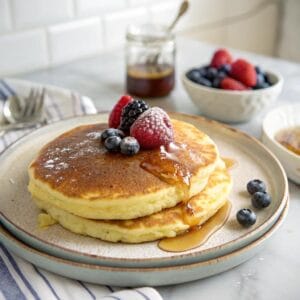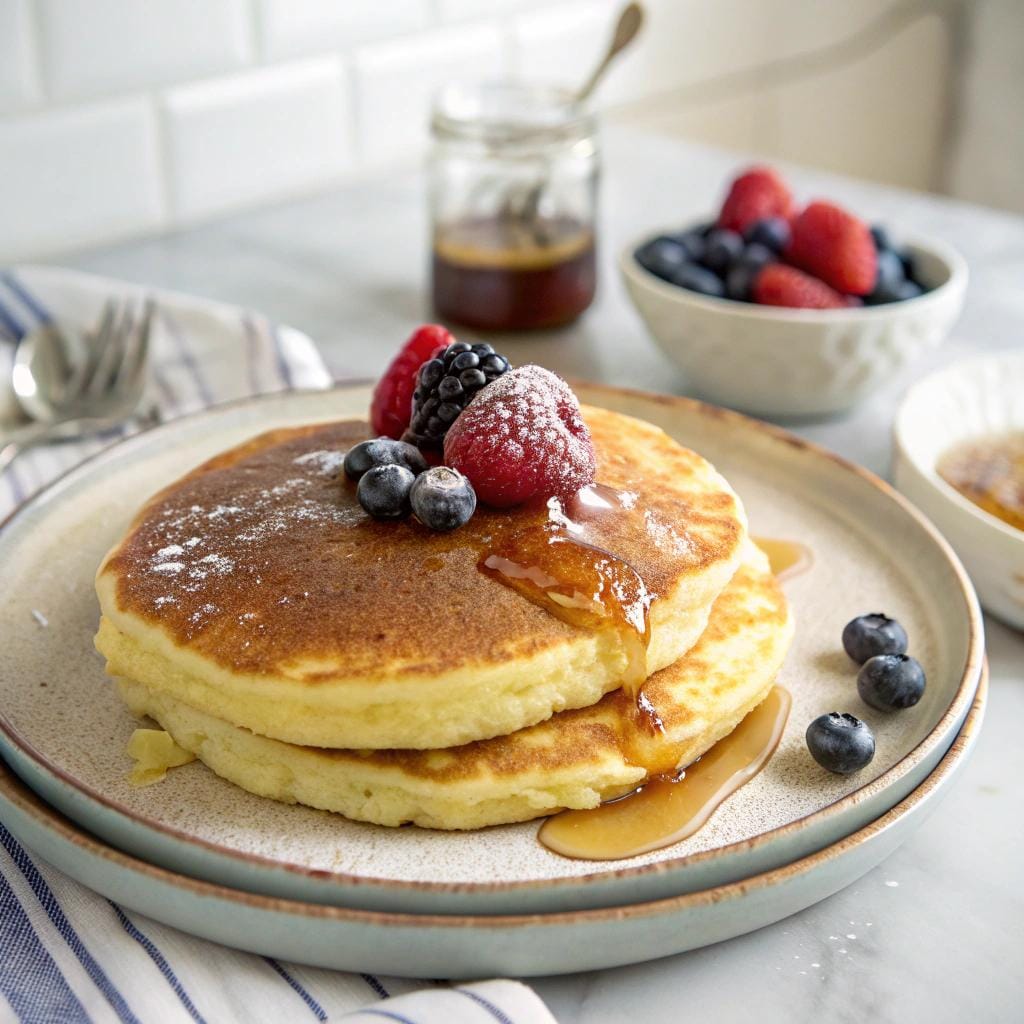Making pancakes without eggs is not only possible but incredibly satisfying. Pancake Recipe Without Eggs caters to dietary needs while delivering the same fluffy and delicious results as traditional recipes. Whether you’re accommodating an egg allergy, following a vegan lifestyle, or simply out of eggs, this guide has you covered. With the right ingredients and techniques, creating these pancakes is straightforward. Transitioning to an egg-free recipe doesn’t mean compromising on taste or texture. This article will help you master the art of egg-free pancakes, ensuring every bite is delightful. Keep reading to discover the secrets behind this versatile breakfast treat.
Table of Contents

Perfect pancake without eggs
Ingredients
- 1 cup all-purpose flour
- 2 tbsp tbsp sugar
- 2 tsp baking powder
- 1/4 tsp salt
- 1 cup milk (dairy or plant-based)
- 2 tbsp vegetable oil or melted butter
- 1 tbsp ground flaxseed + 3 tbsp water (egg substitute)
- 1/2 tsp vanilla extract (optional)
Instructions
- In a small bowl, mix ground flaxseed with water and set aside to thicken (about 5 minutes).
- In a large mixing bowl, whisk together flour, sugar, baking powder, and salt.
- In another bowl, combine the milk, oil, vanilla extract (if using), and the flaxseed mixture.
- Pour the wet ingredients into the dry and gently mix until just combined. Do not overmix.
- Let the batter rest for 5–10 minutes to activate the baking powd
- Heat a non-stick skillet over medium heat and lightly grease it.
- Scoop 1/4 cup of batter for each pancake onto the skillet.
- Cook until bubbles form on the surface, then flip and cook the other side until golden brown.
- Serve warm with your favorite toppings.
Notes
- You can substitute applesauce, mashed banana, or non-dairy yogurt for the flaxseed mix.
- Avoid overmixing for fluffier pancakes.
- Store leftovers in the fridge for up to 3 days, or freeze with parchment between layers for up to 2 months.
Key Ingredients for Pancakes Without Eggs
The key to a successful Pancake Recipe Without Eggs lies in choosing the right ingredients. While the absence of eggs might seem challenging, several substitutes can replicate their binding and leavening properties.
- All-purpose flour: A versatile base for your pancakes.
- Baking powder: Provides the fluffiness that eggs usually contribute.
- Salt: Enhances the overall flavor.
- Milk or plant-based milk: Adds moisture and richness.
- Oil or melted butter: Ensures a soft and moist texture.
- Egg substitute: Options include mashed banana, applesauce, yogurt, or flaxseed meal mixed with water.
These components create a balanced batter that ensures your pancakes are as delicious as their egg-containing counterparts. By choosing quality ingredients, you’ll achieve consistent results every time.
Top off your egg-free pancakes with this easy blueberry syrup recipe – it’s bright, fruity, and made with just a handful of ingredients.
Step-by-Step Guide to Pancake Without Eggs
Crafting the perfect Pancake Recipe Without Eggs requires a simple process. Follow these steps for a foolproof method:
- Prepare your ingredients: Measure your flour, baking powder, salt, and sugar if desired.
- Mix the dry ingredients: Combine them in a large mixing bowl.
- Whisk the wet ingredients: In a separate bowl, mix milk, oil, and your chosen egg substitute.
- Combine the mixtures: Gradually incorporate the wet ingredients into the dry ingredients, stirring gently.
- Preheat your skillet: Heat a non-stick pan over medium heat and lightly grease it.
- Cook the pancakes: Pour ¼ cup of batter for each pancake. Cook until bubbles form, then flip and cook until golden brown.
- Serve and enjoy: Pair your pancakes with syrup, fruit, or other favorite toppings.
This straightforward process ensures your pancakes are fluffy, flavorful, and egg-free.
Try pairing your egg-free pancakes with my easy homemade blueberry syrup for a naturally sweet breakfast boost.
The Science Behind Egg-Free Pancakes
Understanding the science behind Pancake Recipe Without Eggs can improve your cooking results. Eggs typically provide structure, moisture, and leavening to pancake batter. When they are removed, substitutes like bananas, applesauce, or flaxseed meal replicate these functions.
- Binding agents: Substitutes hold the ingredients together, maintaining the pancake’s structure.
- Leavening properties: Baking powder compensates for the rise eggs usually provide.
- Moisture content: Alternatives like yogurt or applesauce ensure the batter doesn’t dry out.
By balancing these factors, your pancakes will achieve the ideal texture and flavor. Experimenting with various substitutes can help you find the perfect match for your recipe.
Creative Variations for Pancake Recipe Without Eggs
Adding variety to your Pancake Recipe Without Eggs can transform a simple breakfast into a flavorful feast. Whether you prefer sweet or savory, there are endless ways to make these pancakes unique and exciting.
- Vegan Delight: Use almond or soy milk along with flaxseed meal as your egg substitute. Add a dash of vanilla extract and a sprinkle of cinnamon for a warm, aromatic flavor.
- Gluten-Free Option: Replace all-purpose flour with almond flour or a gluten-free blend. Pair this with mashed bananas or unsweetened applesauce for added moisture.
- Berry Explosion: Fold fresh or frozen blueberries, raspberries, or sliced strawberries into the batter. They add bursts of fruity sweetness and vibrant color.
- Chocolate Lovers’ Dream: Mix dairy-free or regular chocolate chips into the batter for a rich, indulgent twist. Top with a drizzle of chocolate syrup for an extra treat.
- Savory Pancakes: Skip the sugar and incorporate chopped herbs, grated zucchini, or shredded cheese. These pancakes make a perfect brunch or dinner option.
Experimenting with these variations lets you create personalized pancakes to suit any occasion or craving. With these creative ideas, your egg-free pancakes will always be anything but ordinary.
Looking for a nutty spin? Try these almond flour mug cakes for a fluffy, gluten-free treat that works great without eggs.
Troubleshooting Common Pancake Issues Without Eggs
Even the best Pancake Recipe Without Eggs can encounter challenges. Here are solutions to common problems:
- Dense pancakes: Ensure your baking powder is fresh and avoid overmixing the batter.
- Pancakes sticking to the pan: Use a non-stick skillet and grease it lightly before cooking.
- Uneven cooking: Maintain consistent heat and avoid overcrowding the pan.
Addressing these issues ensures a smooth cooking experience and perfect pancakes every time.
Serving Ideas for Pancake Recipe Without Eggs
The right toppings elevate your Pancake Recipe Without Eggs to new heights. Consider these ideas:
- Sweet toppings: Fresh fruits, maple syrup, or powdered sugar.
- Savory options: Peanut butter, yogurt, or cream cheese.
- Beverage pairings: Coffee, tea, or freshly squeezed juice.
Customizing your pancakes with these accompaniments creates a well-rounded and satisfying meal.
Serve these pancakes alongside a cup of stovetop hot chocolate for a cozy, eggless breakfast your whole family will love.
Nutritional Insights for Pancakes Without Eggs
One of the best features of a Pancake Recipe Without Eggs is its flexibility to fit into various dietary preferences while still providing essential nutrients. Without eggs, these pancakes can be lower in cholesterol, making them suitable for heart-healthy diets. The nutritional value of your pancakes depends on the ingredients you choose, offering opportunities to boost their health benefits.
- Calories: A serving of two pancakes typically contains around 150-200 calories, depending on the use of milk or oil.
- Carbohydrates: Flour provides the bulk of carbohydrates, giving the pancakes their fluffy texture and energy-rich profile.
- Protein: While eggs are a traditional protein source, substitutes like flaxseed meal, yogurt, or plant-based milk can add protein content.
- Fat: Oil or butter contributes to the pancakes’ moist texture, and the fat content can be adjusted by using lower-fat alternatives.
Incorporating whole grains, adding seeds, or using almond flour are ways to enhance the nutritional profile of your egg-free pancakes, ensuring a balanced meal that’s delicious and health-conscious.
Beginner’s Tips for Making Pancake Recipe Without Eggs
If you’re new to making a Pancake Recipe Without Eggs, follow these tips to ensure success from the start. Creating fluffy, flavorful pancakes without eggs is easy when you use the right techniques and ingredients.
- Choose the Right Substitute: Experiment with banana, applesauce, or flaxseed meal mixed with water to find the flavor and texture you prefer.
- Don’t Overmix: Stir the batter just enough to combine ingredients. Overmixing can lead to dense pancakes.
- Let the Batter Rest: Allowing the batter to sit for 5-10 minutes gives the baking powder time to activate, resulting in fluffier pancakes.
- Preheat Your Pan: Ensure your skillet is evenly heated and lightly greased before pouring the batter.
- Use Consistent Measurements: Use a measuring cup to pour the batter, ensuring uniform pancake sizes.
- Cook on Medium Heat: Too high heat can burn the outside while leaving the center undercooked. Medium heat ensures even cooking.
With these tips, even beginners can create impressive pancakes without eggs that rival traditional recipes in taste and texture.
How to Store and Reheat Pancakes Without Eggs
Storing and reheating your Pancake Recipe Without Eggs properly ensures they remain fresh and delicious for future meals. Here’s how to handle leftovers effectively:
Storing Pancakes:
- Refrigeration: Allow pancakes to cool completely before placing them in an airtight container. Store in the refrigerator for up to 3 days.
- Freezing: Stack pancakes with parchment paper between each layer to prevent sticking. Place them in a freezer-safe bag or container for up to 2 months.
Reheating Pancakes:
- Microwave: Heat pancakes for 20-30 seconds. Cover with a damp paper towel to retain moisture.
- Oven: Preheat the oven to 350°F (175°C). Place pancakes on a baking sheet and heat for 5-7 minutes.
- Toaster: For a crispier texture, warm pancakes in a toaster. Ensure they don’t overlap.
Proper storage and reheating techniques maintain the flavor and texture of your egg-free pancakes, making them just as enjoyable as freshly made ones.
Benefits of Baking Without Eggs
Baking without eggs offers a variety of benefits, both dietary and practical. A Pancake Recipe Without Eggs is a testament to how simple ingredients can create remarkable results.
- Dietary Inclusivity: Egg-free recipes cater to vegans, individuals with egg allergies, and those following specific dietary restrictions.
- Cost-Effective: Eggs can be expensive, especially when baking in large quantities. Substitutes like bananas or applesauce are affordable alternatives.
- Health Benefits: Egg-free pancakes can be lower in cholesterol and saturated fats, making them suitable for heart-healthy diets.
- Environmental Impact: Plant-based recipes reduce reliance on animal products, promoting sustainable practices.
- Experimentation: Removing eggs opens opportunities to try new ingredients and flavor profiles, enhancing creativity in the kitchen.
These benefits make baking without eggs a versatile and rewarding approach for both novice and experienced cooks.
Love egg-free recipes? You’ll also want to bookmark this vegan protein mug cake – it’s rich, moist, and packed with plant-based goodness.
Cultural Takes on Pancakes Without Eggs
Pancakes are a universal dish, and many cultures have traditional versions that naturally align with the concept of a Pancake Recipe Without Eggs. Here are a few global inspirations:
- Indian Dosa: A savory pancake made with rice and lentil batter, traditionally egg-free.
- Japanese Okonomiyaki: While modern versions may include eggs, traditional recipes can be adapted without them.
- Russian Blini: These thin pancakes are often made with minimal ingredients, making egg-free variations simple.
- Swedish Pancakes: With a light, crepe-like texture, they can be made egg-free by using substitutes like aquafaba or yogurt.
- Mexican Hotcakes: Typically flavored with cinnamon and vanilla, these pancakes are easily made without eggs.
Exploring cultural variations showcases the versatility and adaptability of pancakes in egg-free forms.
Expert Advice for Flawless Pancake Recipe Without Eggs
Creating the perfect Pancake Recipe Without Eggs takes practice, but expert advice can guide you to consistently excellent results:
- Sift Dry Ingredients: Sifting flour and baking powder ensures a smoother batter.
- Experiment with Substitutes: Find the egg alternative that works best for your taste and texture preferences.
- Use Room Temperature Ingredients: This helps the batter mix evenly, avoiding lumps.
- Preheat Evenly: Allow your skillet or griddle to preheat thoroughly for consistent cooking.
- Test with a Small Pancake: Cook a small portion first to adjust heat or batter consistency.
- Flip at the Right Time: Wait until bubbles appear and the edges set before flipping to avoid sticking.
Following these tips will elevate your pancakes to professional-level quality, ensuring they’re a hit every time.
FAQs :
What can I use instead of eggs in a pancake?
You’ve got options! Mashed banana, applesauce, yogurt, or even a flaxseed-water mix can replace eggs. Each one adds moisture and binding, just like eggs do—no fancy ingredients required.
Can I make pancakes without eggs?
Absolutely! Pancakes don’t rely solely on eggs to fluff up. With the right mix of baking powder and a splash of milk (dairy or plant-based), you’ll still get those golden, airy stacks you’re craving. Just keep your wet-to-dry ratio balanced, and flip gently. They’re just as satisfying—no egg necessary.
Can I skip eggs in pancake mix?
You sure can. If you’re working with a store-bought mix, just leave out the egg and add an extra tablespoon or two of oil or melted butter to keep the batter moist. Most mixes already include leaveners, so you won’t lose that fluff. Bonus: it’s perfect for those avoiding eggs due to allergies or dietary choices.
How to make easy pancakes with 3 ingredients?
It’s easier than you think! All you need is self-rising flour, milk, and a touch of sugar (or mashed banana for natural sweetness). Mix them up until just combined—lumps are totally fine—and cook on a hot, greased pan. In minutes, you’ll have a simple stack that’s fluffy, golden, and ready for your favorite toppings.
Conclusion: Enjoying Pancakes Without Eggs
Mastering a Pancake Recipe Without Eggs opens up a world of possibilities for creative and inclusive cooking. From the nutritional benefits to the ease of adapting recipes, egg-free pancakes prove that simplicity and flavor can go hand in hand. Whether you’re exploring cultural variations or perfecting your own technique, the joy of creating and sharing these pancakes is undeniable. So gather your ingredients, try the tips shared here, and enjoy the delightful experience of making pancakes without eggs. Your breakfast table will never be the same!


2 thoughts on “The Ultimate Guide to Perfect Pancake Recipe Without Eggs”